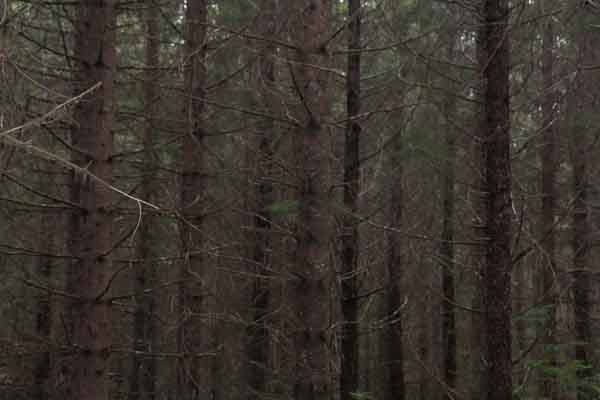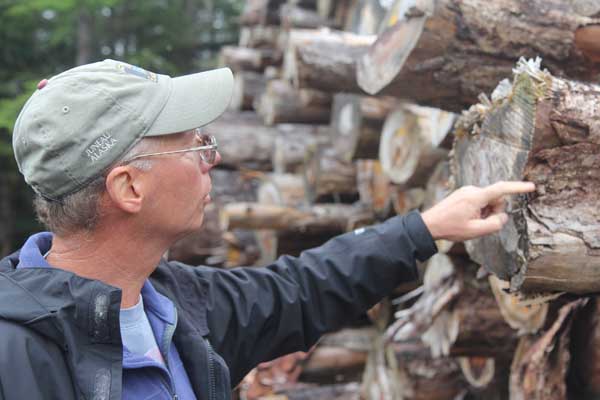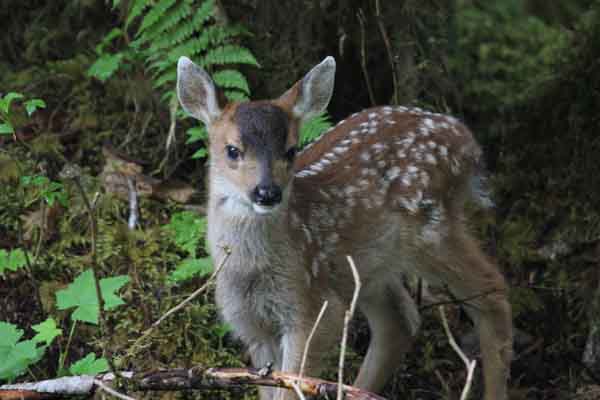I’m enjoying a halibut sandwich and microbrew in Ketchikan, Alaska, when a group of cruise ship passengers file in, giddy as they recall all the sights they had experienced over the past few days. I overhear talk of bears and eagles and glaciers. And then one man exclaiming: “I’ve never seen such beautiful and pristine forests.”
I’d just spent a week with foresters and researchers in those southeastern Alaskan forests, a short plane flight away on Prince of Wales Island.
Beautiful? Oh, absolutely.
Pristine? Well. Not quite.
From the roads on Prince of Wales, the forest does indeed seem to stretch untouched. That’s an illusion. This is young growth forest, trees that have grown following extensive logging, often by clearcutting, thirty years ago.
And, unlike pristine forest, these trees are all the same age, creating a uniformity that is not ideal for wildlife habitat. It’s also not good for the economy: young growth trees have traditionally have had low market potential.
So: the forests here may superficially look great, but some are in need of restoration.
Is there a way to ecologically restore the forests on Prince of Wales while also creating economic opportunities for local communities? That’s the question at the heart of research and work here by Nature Conservancy foresters.
Old Growth, Young Growth

To understand the issues around the young growth forests that cover much of Prince of Wales Island, Conservancy conservation forester Keith Rush and field representative Michael Kampnich first take me to a patch of remaining old growth forest.
It’s like stepping into an enchanted forest, the rays of light filtering through giant trees straight out of a calendar image. There are 500 and 800-year-old trees here – spruce, cedars – but also small bushes sprouting where trees have fallen over. The walking is easy: indeed, deer trails snake through the moss and brush. Bear scat appears frequently in openings.
“What you’re seeing here are the characteristics of old growth,” Rush says, as he points around us. “There are not many trees in any given space but many of the trees are big. There is a lot of diversity, with trees of all sizes and ages. There are gaps filled with shrubs, and dead wood that is both on the ground and standing. The wildlife species here evolved with old growth. All of this is critical for wildlife. All of it.”
The forest that we’re walking through once covered the entirety of Prince of Wales Island, the third largest island in the United States. National forest and tribal land account for much of the island, and by the 1980s, most of it was being logged. Hard.
Huge mills were processing a billion board feet of timber a year. Prince of Wales Island receives a lot of precipitation (11 feet of rain per year) and has good growing conditions. The forests grew back. But the diversity was gone.
Rush and Kampnich next drove me to a young growth forest stand. That seemingly beautiful forest seen from the road – or cruise ship – was now a bit less appealing to walk through. Make that: to try to walk through.
It was a dense stand of thin trees, blocking out the sun. No shrubs grew on the ground. Whereas old growth stands had 30 trees per acre, this stand had more than 500 trees per acre.
“There’s very low biodiversity here,” says Rush. “There are no gaps in the forest, so sunlight is unable to penetrate. There’s no standing dead wood to provide homes for birds. There’s no fallen dead wood decaying. There isn’t browse for deer. ”
“It wasn’t cutting this particular stand that was the problem,” adds Kampnich, who previously worked as a logger. “It was the scale that was the problem. It’s all like this. Everything is the same. We have one uniform, dense stand of trees.”
It’s logging that created these conditions, so it may come as a surprise that it’s logging that offers the best solution to ecological restoration.
“Our goal is to balance ecological needs with the community’s economic and social needs,” says Rush. “That means researching the best ways to restore a healthy forest, but also researching markets for young growth that allow communities to prosper.”
Let the Sunshine In

The ecological restoration, it turns out, is relatively straightforward. Decades of forestry research have shown ecologists how to restore uniform, dense stands of trees to a more diverse forest.
The first step: “Knock some holes in that dense canopy and let light get to the forest floor,” says Rush.
Foresters do this by cutting patches of trees. Understory—the shrubs that spring up in light—start sprouting almost immediately, creating ample browse for black-tailed deer and other wildlife. Indeed, the restoration sites we visited were covered in tracks, droppings and other sign left by deer and black bear.
Tree cutting for restoration is a bit different than standard tree harvesting. Old, dead trees are left standing for wildlife. Instead of one uniform cut, managers make multiple cuts over a period of time.
Still: the science behind conservation forestry is pretty straightforward. The Conservancy is working with the U.S. Forest Service wildlife staff to identify critical habitat that is in need of restoration.
But restoring the forest on Prince of Wales Island isn’t just about forestry. It’s also about markets.
Inventing an Industry

Restoration doesn’t occur in a vacuum. The U.S. Forest Service, the agency that manages the Tongass National Forest on Princes of Wales, and local communities must have an incentive to undertake restoration. To date, the timber economy on the island has been built around old growth forests.
To restore forests and sustain communities means transitioning to harvesting young growth trees, and the U.S. Forest Service has expressed its commitment to this transition.
“Trying to invent an industry from the ground up is a huge task,” says Rush. “I’m a restoration forester. I’m trained to look at how restoration affects wildlife and water. Now I’m also looking at market research. It may seem unrelated, but without those markets we aren’t going to restore the forest.”
Many locals are skeptical that such markets exist. “A lot of old-school timber folks turn their noses up at young growth wood,” says Kampnich. “And in part, that’s a justifiable reaction. Young growth wood has a small diameter and finished materials produced from it will be different than old growth products.”
Conservancy foresters are working to with local mills to test market wood products cut from young growth. Working with skilled millers, they’re finding that small-diameter logs can still yield quality wood products.
They’re also working with cabinet makers and even home builders to create niche markets for their products. Another market possibility is using wood biomass for home heating; pellet stoves are more efficient than fuel oil.
“We have to find niche markets,” says Rush. “We need to get the most out of a log that we can. The markets have to help offset the costs of the ecological treatments.”
But Prince of Wales Island faces other challenges with markets. After all, much of the United States and Canada has young growth forests. Many of those areas have longer growing seasons, better soils and established infrastructure to access consumers (Prince of Wales can only be reached by boat or plane).
“We have to explore opportunities for local markets,” says Kampnich. “We have to put finished products out there and see if there’s interest.”
To help overcome these challenges, The Nature Conservancy has provided lumber from young growth forests to local mills and fronted the costs for marketing. The Conservancy then is helping to test market the products, including interior paneling and home building materials.
Logging young growth forests may not return the forests to a pristine state, but it will create a forest that’s healthier, better for wildlife and outdoor recreation and ultimately more economically sustainable for local communities. But the ecological success of the project remains tied to marketing.
“To achieve conservation gain, we have to make restoration more affordable,” says Rush. “To do that, we need to transition the timber economy towards young growth wood. The two main issues mills face are access to timber and product marketing. Conservationists can help with that. It may be a new role, but if we get it right we’ll benefit forests, wildlife and people.”




Join the Discussion
2 comments